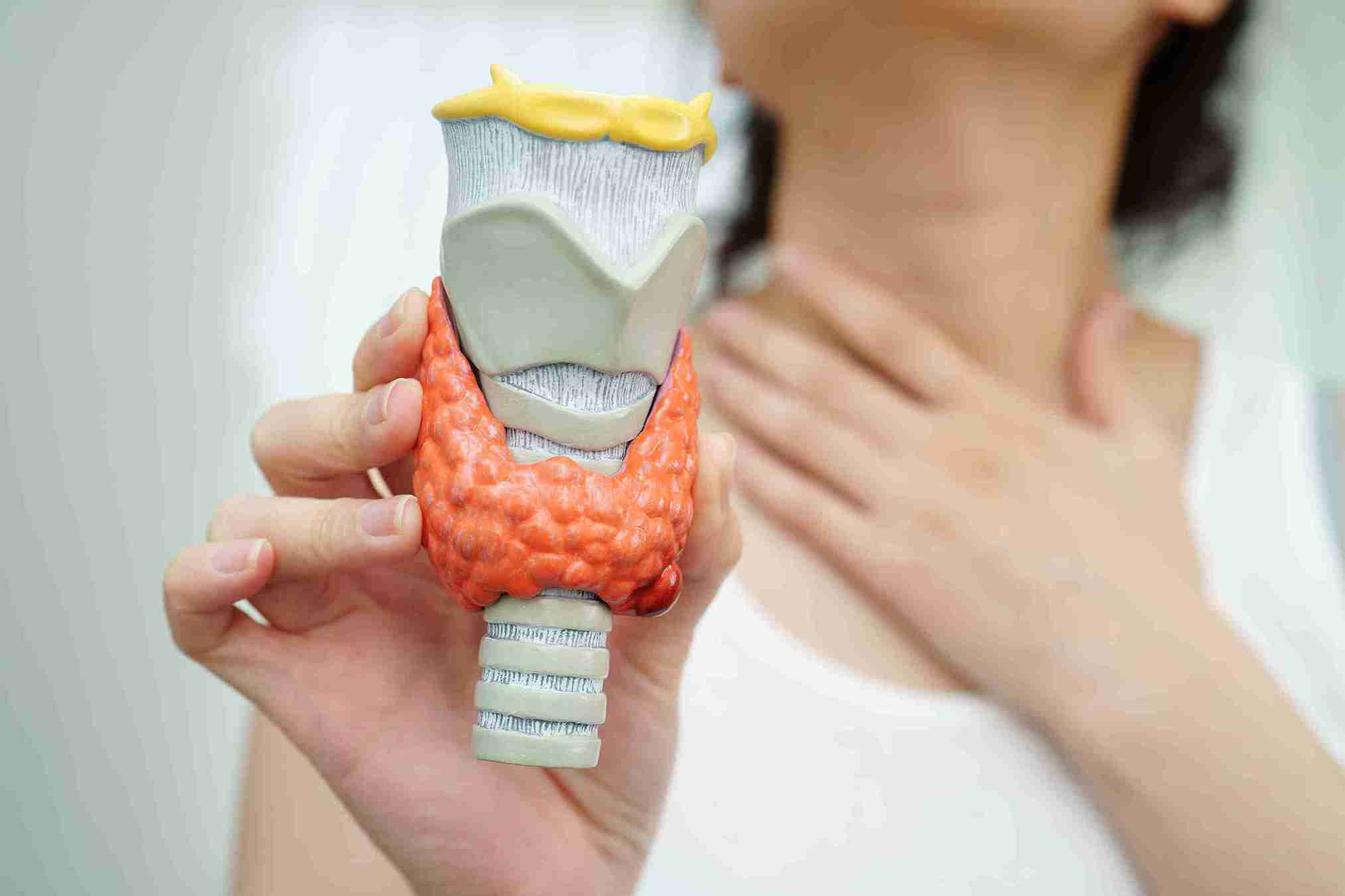
Hormones play a vital role in keeping our bodies functioning smoothly. When hormone levels become too high or too low, it can affect everything from energy levels to mood and metabolism. Hormone imbalances can lead to a range of health concerns, some subtle and others more noticeable.
Most of the hormones in our bodies are secreted by specialised organs called glands, such as the hypothalamus, pancreas, thyroid, etc. In this article, we’ll focus on the thyroid gland and explore two common conditions linked to it: hypothyroidism and hyperthyroidism. Though the names of these two conditions are similar, they affect the body in very different ways. Understanding the difference between their symptoms may be helpful in recognising the signs of thyroid problems early and seeking the right kind of medical help and treatment.

In front of the neck, just below the larynx, there is a two-inch-long butterfly-shaped gland that plays a pivotal role in regulating the speed of the body’s metabolic activity. This is the thyroid gland, a crucial component of the endocrine system.
The thyroid gland makes and secretes the following hormones:
1. Thyroxine (T4)
2. Triiodothyronine (T3)
3. Reverse triiodothyronine (RT3)
4. Calcitonin
The hormones produced by the thyroid gland are responsible for:
● Regulating the speed at which food is converted to energy (metabolism)
● Respiration
● Heart rate
● Body temperature
● Reproductive health and fertility
● Growth and development
● Brain development
● Digestion
From this, it is evident that the thyroid plays a vital role in the body, and any fluctuations in the levels of hormones it produces can have far-reaching consequences.
Thyroid diseases occur when the thyroid gland is unable to produce the correct levels of the hormones. This form of hormone imbalance is quite common, and it can occur at any age. Females are more prone to it than males.
Since hormones secreted by the thyroid gland help in regulating vital body functions, the occurrence of thyroid diseases can have far-reaching implications for the entire body. Therefore, it is necessary to be aware of the two types of thyroid diseases so that treatment and management can be started at the earliest.
There are two main types of thyroid disorders: hypothyroidism and hyperthyroidism. While their names may sound alike, they differ in many ways, most notably in their underlying causes.
To gain a deeper understanding, let’s examine these medical conditions in more detail.
Hyperthyroidism, or an overactive thyroid, occurs when the thyroid gland produces and secretes excessive amounts of thyroid hormone. This is a relatively rare disorder that leads to a faster metabolism, which in turn can significantly impact several bodily functions and disrupt overall balance. It may cause a range of symptoms that affect physical and emotional health.
Given below is a list of some of the most common hyperthyroidism symptoms that can be noticed in people with this disorder:
● Abnormal weight loss despite a healthy appetite and regular intake of food
● High blood pressure
● Heart palpitations and rapid heart rate
● Insomnia
● Increased hair breakage or hair fall
● Irregular menstrual cycle
● Presence of swelling or goitre in the neck
● Bulging eyes
● Excessive sweating and a heightened sensitivity to heat.

There are several reasons behind the occurrence of hyperthyroidism, and these are:
Graves’ Disease is an autoimmune disorder that triggers the overproduction of an antibody called thyroid-stimulating immunoglobulin (TSI). This imbalance makes the thyroid gland secrete abnormally high levels of thyroid hormones.
Thyroid nodules are growths or lumps, usually benign, that occur on the thyroid gland, causing it to become overactive.
The pituitary gland releases thyroid-stimulating hormone (TSH) to prompt the thyroid gland to produce thyroid hormones. In some cases, a tumour in the pituitary gland may lead to the production of too much TSH, causing the thyroid to become overactive.
The thyroid gland needs iodine to create thyroid hormones. Therefore, excessive consumption of iodine-containing food or medication can lead to hyperthyroidism.
Temporary hyperthyroidism can be caused by an inflammation of the thyroid gland, known as thyroiditis.
Hyperthyroidism can affect anyone, but certain factors may increase the chances of developing this condition.
● People with a family history of thyroid diseases.
● People with autoimmune disorders.
● Smoking tobacco can increase the likelihood of developing Graves' disease, which in turn can lead to hyperthyroidism.
● Pregnant women may be at risk of getting postpartum thyroiditis, an inflammation of the thyroid gland.
If left untreated, hyperthyroidism can lead to several serious issues, such as:
● Atrial Fibrillation (AFib), a condition that causes irregular heart rhythm, leading to cardiovascular issues like heart attacks and strokes.
● An ischemic stroke, when there is a disruption of blood flow to the brain.
● Osteoporosis
● Congestive heart failure
● Fertility issues
Hyperthyroidism can be treated in several ways, depending on the cause of the disorder and the extent of the severity. Here are some of the common treatment paths recommended by healthcare providers:
● Antithyroid medications like methimazole and propylthiouracil may be prescribed to disrupt the production of thyroid hormones.
● Radioactive iodine (RAI) therapy, whereby a single dose of radioactive iodine is used to destroy overactive thyroid cells. It often cures hyperthyroidism but usually results in permanent thyroid damage, requiring lifelong thyroid hormone replacement.
● Surgical removal of the thyroid gland.
● Beta-blockers help relieve symptoms like rapid heartbeat and shakiness in hyperthyroidism, but don’t affect hormone levels. They’re often used alongside other treatments.
The second type of thyroid disease is hypothyroidism, or underactive thyroid disease. This occurs when the thyroid gland produces and secretes insufficient amounts of thyroid hormone, leading to slower metabolic activity.
Given below is a list of some of the most common hypothyroidism symptoms that typically develop over a long period of time:
● Weight gain without any apparent reason, despite a normal lifestyle and diet
● Brain fog or difficulty with memory and the ability to focus.
● Mental health issues like depression or anxiety.
● Dry, rough skin and hair
● Higher-than-normal cholesterol levels
● Abnormally heavy and frequent menstrual periods
● Fatigue
● Sensitivity to cold
● A feeling of tingling or numbness in the hands
● Muscle soreness or weakness
● Hoarse voice

There are several reasons behind the occurrence of hypothyroidism, and these are:
1. Congenital conditions, such as being born without a thyroid gland or with an impaired one.
2. Iodine deficiency caused by a poor diet, or non-inclusion of iodine-rich foods like fish, eggs, dairy, etc.
3. Thyroiditis, in this case, is an inflammation that impairs the thyroid gland's ability to produce optimal levels of thyroid hormones.
4. Conditions affecting the pituitary gland, such as benign (noncancerous) tumours.
5. Some medications, such as lithium, thalidomide, and amiodarone, may contribute to the condition.
Certain factors may increase the chances of developing this condition, including:
● Being female
● Having an autoimmune disease
● Having a family history that shows close relatives with the same disorder.
● Being pregnant or having recently given birth, as postpartum thyroiditis can sometimes lead to hypothyroidism.
● Having undergone radiation treatment to the head or neck in the past.
● Having thyroid gland surgery.
● Reactions to the intake or stoppage of certain medications.
If treatment for hypothyroidism is not done in time, it can lead to several serious issues, such as:
● Abnormal enlargement of the thyroid gland, also known as goitre.
● Fertility issues that affect the chance of successful conception.
● Birth of children with congenital health issues.
● Miscarriages.
● Impaired heart health.
● Nerve diseases like peripheral neuropathy.
● A rare condition called myxedema coma.
Hypothyroidism is quite common and is fairly easily treatable. The main treatment for hypothyroidism is hormone replacement therapy. A common medication used is levothyroxine, which replaces the thyroid hormones the body can no longer produce. Treatment is typically lifelong, and over time, it helps restore hormone balance and ease symptoms. Noticeable improvement will happen within a few weeks of starting treatment.
Can A Person Have Both Hypothyroidism and Hyperthyroidism?
In a few cases, such as with thyroiditis or postpartum thyroiditis, hyperthyroidism may occur initially, followed by hypothyroidism. This is usually a temporary condition and resolves soon.
For both hyperthyroidism and hypothyroidism, the diagnostic measures are somewhat similar. Diagnosis involves:
Blood tests can be used to confirm the presence of both types of thyroid diseases. These blood tests will be used to measure the levels of TSH, T3 and T4, as well as the presence of thyroid antibodies.
Imaging tests, such as thyroid ultrasound, can help detect lumps (nodules) or an enlarged thyroid (goitre). Nuclear scans, such as a thyroid uptake and scan, may be used to determine if any nodules are producing excess hormones.

Being aware of thyroid disorders and the difference between the two main types (hyperthyroidism and hypothyroidism) is a must. The hormonal imbalances caused by these kinds of diseases can have serious effects on one’s health. Therefore, it is prudent to consult a doctor if any of the symptoms mentioned in this article are noticed, to enable early diagnosis and treatment.

Hypothyroidism refers to a type of thyroid disease characterised by inadequate production of thyroid hormones. Hyperthyroidism refers to a condition in which the thyroid gland produces excessive thyroid hormones.

The most common symptom of hypothyroidism is abnormal weight gain despite a healthy diet and lifestyle, along with fatigue and sensitivity to cold. There may be heavy menstrual periods and fertility issues.

The most common symptoms of hyperthyroidism include abnormal weight loss with no apparent reason, goitre or swelling in the neck, irregular menstrual cycle, etc.

Hypothyroidism is caused by factors that hinder thyroid hormone production, such as iodine deficiency, benign tumours in the pituitary gland, absence or impairment of the thyroid gland, etc. Hyperthyroidism, on the other hand, is caused by factors that trigger excessive hormone production, such as high iodine consumption, Graves’ disease, thyroid nodules, etc. In some cases, such as in thyroiditis, both conditions may occur temporarily, one after the other.